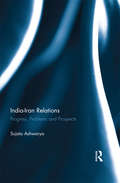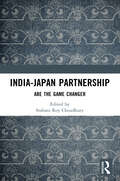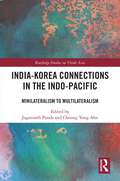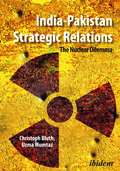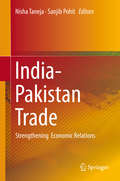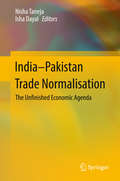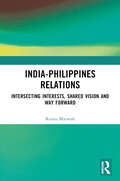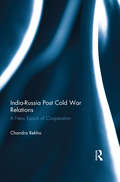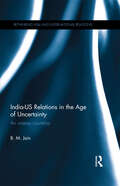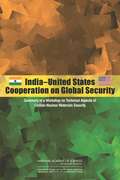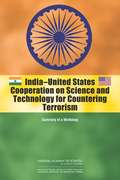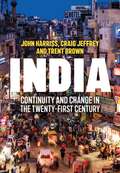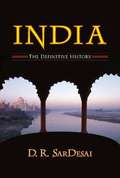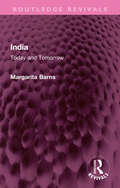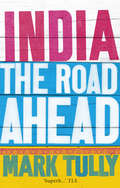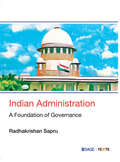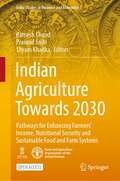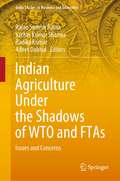- Table View
- List View
India-China Maritime Competition: The Security Dilemma at Sea (Cass Series: Naval Policy and History)
by T. V. Paul Rajesh Basrur Anit MukherjeeThis edited volume critically examines the concept of the “security dilemma” and applies it to India–China maritime competition. Though frequently employed in academic discussion and popular commentary on the Sino-Indian relationship, the term has rarely been critically analysed. The volume addresses the gap by examining whether the security dilemma is a useful concept in explaining the naval and foreign policy strategies of India and China. China’s Belt and Road Initiative and its expansive engagement in the Indian Ocean Region have resulted in India significantly scaling up investment in its navy, adding ships, naval aircraft and submarines. This volume investigates how the rivalry is playing out in different sub-regions of the Indian Ocean, and the responses of other powers, notably the United States and prominent Southeast Asian states. Their reactions to the Sino-Indian rivalry are an underexplored topic and the chapters in this book reveal how they selectively use that rivalry while trying to steer clear of making definite choices. The book concludes with recommendations on mitigating the security dilemma. This work will be of great interest to students of strategic studies, international relations, maritime security, and Asian politics.
India-Iran Relations: Progress, Problems and Prospects
by Sujata AshwaryaThis book examines India’s relationship with Iran since the post-World War II period and its unique search for meaningful bilateral ties in the West Asian region in the context of the changing regional and international scenarios. The four chapters highlight the achievements and constraints on the development of Indo-Iranian relations during the Cold War era; opportunities and limitations in bilateral engagements between India and Iran in the aftermath of the Cold War; impact of the ‘US factor’ on the development of crucial Indo-Iranian energy ties and the limitation imposed by India’s relations with Israel and Saudi Arabia on the India–Iran ties. More specifically, the four chapters touch on the central drivers—energy imports, access to Central Asia, cooperation in Afghanistan, mutual trade and economic investments and security ties—of India’s Iran policy, and how they structure India’s interaction with the other countries of the region and impact on the articulation of national interests. Combining a rich interplay of facts and figures with nuanced analyses, this volume will be a valuable resource for scholars, policymakers, diplomats and any interested reader desirous of knowing more about Indo-Iranian relations in particular and India’s West Asia policy in general. Please note: Taylor & Francis does not sell or distribute the Hardback in India, Pakistan, Nepal, Bhutan, Bangladesh and Sri Lanka
India-Japan Partnership: Abe the Game Changer
by Srabani Roy ChoudhuryThis book discusses the influence and impact of Shinzo Abe, Japan’s youngest and longest-serving Prime Minister in the post-Second World War, on international relations between India and Japan. The subject matter concentrates on Abe’s 2006-2007 and 2012-2020 regimes. Building on civilisation linkages, shared values, and mutual interest, Abe pegged the relationship with India as a strategic requirement for his vision for the Indo-Pacific region. Drawing linkages between Abe’s vision for Japan and India’s ambition at the world theatre, the contributing authors explore the various dimensions of this partnership. Critically appraising this bilateral relation, drawing on the convergence of India-Japan interest in the multilateral form, Abe’s impact on the media, and his display of soft power diplomacy, this book analyses the diverse spheres that have spun this partnership to a new orbit.Print edition not for sale in South Asia (India, Sri Lanka, Nepal, Bangladesh, Pakistan and Bhutan)
India-Korea Connections in the Indo-Pacific: Minilateralism to Multilateralism (Routledge Studies on Think Asia)
by Choong Yong Ahn Jagannath PandaIndia‑Korea Connections in the Indo‑Pacific presents multidimensional aspects of the Special Strategic Relationship between the Republic of Korea (ROK) and India, ranging from security, diplomacy, trade and FDI, and people‑to‑people exchanges. It analyses the India‑Korea partnership and its strategic implications and potential in the Indo‑Pacific.Bringing together experts from both India and the ROK, this book situates the partnership in the context of the current geopolitical landscape in the Indo‑Pacific, particularly the increasingly intensifying US‑China rivalry and the post‑pandemic and geo‑economic fragmentation caused by the Russian invasion of Ukraine. In this context, the chapters explore how the ROK and India as middle powers can strengthen the bilateral relationship between India and ROK and then work together within a host of existing minilateral and multilateral architectures in the Indo‑Pacific for a rule‑based international order embracing security and diplomacy, supply chain resilience, and cross‑border FDI and trade cooperation as evident in Quad, IPEF, RCEP, CPTPP, DEPA. This book is a unique collaboration between experts across various domains from both countries, and it presents a new take on the India‑ROK bilateral relationship as a middle power axis in the Indo‑Pacific.Presenting action‑oriented policy recommendations for ROK and India to pursue an upgradation of the existing ROK‑India Special Strategic Partnership, this book will be of interest to researchers in the fields of Asian/Indo‑Pacific studies, international relations and political science, looking to understand the India‑Korea partnership and its strategic implications and potential in the Indo‑Pacific, and policy analysts and professionals working in think tanks and research institutions, focused on foreign and security dynamics in the Indo‑Pacific.
India-Pakistan
by Ashutosh MisraThis book is an attempt to dig out the positive aspects of past Indo-Pakistani engagements and explore the relevant lessons to help resolve the current issues and disputes.
India-Pakistan Strategic Relations: The Nuclear Dilemma
by Christoph Bluth Uzma MumtazIndia and Pakistan have been in a state of persistent conflict that goes back to the very creation of these states after decolonization. This conflict has resulted in several wars and continuing armed clashes. After both states became nuclear powers, one would have expected a fundamental change in the way they wage war, since it is a fundamental principle of International Relations theory that nuclear-armed states do not go to war with each other. But the situation in South Asia seems to defy this principle. India’s conventional superiority should be neutralized by Pakistan’s nuclear capability, while Pakistan’s risk-taking behavior should be reduced. But as a matter of fact, the situation has turned out quite differently: Although large-scale conventional wars have not occurred, the nuclear status seems to have encouraged conflict and risk-taking. The number of armed clashes rose. Bluth and Mumtaz scrutinize the atypical and seemingly paradoxical impact of nuclearization on the conflict between India and Pakistan, paying extra attention on the question of how stable this paradoxical strategic relation-ship is. They demonstrate that the dominant paradigm used in the International Relations literature is by far not adequate to explain the strategic relations between India and Pakistan and set to work on developing a more coherent explanation. A must-read for everyone interested in International Relations and conflict resolution research.
India-Pakistan Trade
by Sanjib Pohit Nisha TanejaExamining the implications of recent important developments, the primary aim of this book is to bridge the gaps in existing literature on India-Pakistan economic engagement and to examine various aspects of the trade normalization process. The book includes familiar themes of India-Pakistan bilateral trade in goods and services, providing new insights into the potential for trade and the challenges involved in realizing it. The respective chapters examine the current trade trends and identify the possible sectors for bilateral FDI flows between the two countries, which could help forge deeper economic ties between them. In light of India's changed investment policy, this analysis is pertinent for investors and policy-makers alike. The book also includes chapters on a variety of unconventional subjects, such as estimating the levels of informal trade, an analysis of a trade perception survey and identifying trade potential using a CGE modeling approach. Further, a number of sectors have been identified for in-depth analysis, including sports goods, healthcare and energy. These sector-based analyses reflect the gap between current levels of trade in the selected industries and the possible trade potential. The studies identify key tradable commodities in the health and sports industries, as well as opportunities for trading in energy. The book thus provides readers with a deep understanding of the process of normalizing economic relations and enhancing bilateral trade at the micro and macro levels, on the basis of which the authors subsequently provide recommendations for policymakers.
India-Pakistan Trade Normalisation
by Nisha Taneja Isha DayalThis book explores the unfinished India-Pakistan Trade normalisation agenda (building upon the themes covered in the book "India-Pakistan Trade: Strengthening Economic Relations" published by Springer in 2014) and discusses the steps that must be undertaken in order to move the bilateral engagement forward. Given the commencement of bilateral state-level talks and the Indian government's emphasis on South Asian integration, it adds impetus to the trade liberalisation process, while also providing essential recommendations for policymakers in both countries. The unfinished agenda faces obstacles such as the list of items for which export from India to Pakistan continues to be restricted; lack of land borders and seamless cross-border transport services, which hampers the realisation of trade potential; negative reporting in the media, which influences traders' perceptions; and the continued occurrence of informal trade resulting from inadequacies of formal trade relations. The book examines various sectors, including the agricultural, textiles, automotive and pharmaceutical industries, given their predominance on the list of restricted items for bilateral trade. It also covers studies on unconventional and under-researched themes concerning informal trade, informational barriers to India-Pakistan trade, and opening new land borders for trade - all of which can play a facilitating role in realizing the untapped trade potential between India and Pakistan. The book also includes the second round of the India-Pakistan trade perception survey, which identifies impediments to India-Pakistan bilateral trade and assesses the change in traders' perceptions since the first round of the survey, which was published in 2014.
India-Pakistan in War and Peace
by J. N. DixitAs the Kashmir dispute brings India and Pakistan ominously close to nuclear war this book provides a compelling account of the history and politics of these two great South Asian rivals. Like the Israel-Palestine struggle, the Indian-Pakistan rivalry is a legacy of history. The two countries went to war within months of becoming independent and, over the following half-century, they have fought three other wars and clashed at the United Nations and every other global forum. It is a complex conflict, over religion and territory with two diametrically opposed views of nationhood and national imagination. J.N. Dixit, former Foreign Secretary of India, and one of the world's leading authorities on the region, has written a balanced and very readable account of the most tempestuous and potentially dangerous flashpoint in international politics.
India-Philippines Relations: Intersecting Interests, Shared Vision and Way Forward
by Reena MarwahThis book outlines 75 years of robust and multi-dimensional diplomatic relations between two democracies – India and the Philippines. Through nine chapters, penned by relying mainly on primary documents, published works, and consultations with experts and practitioners, this book takes the reader beyond historical, civilisational, political and economic synergies to locate the partnership and its potential in both bilateral and multilateral areas.This volume responds to questions such as: What explains the need to strengthen India-Philippines partnership undergirded by their historical, diasporic and cultural affinities? How have both New Delhi and Manila reassessed their economic and strategic visions in the context of the transforming Indo-Pacific discourses? Given that defence cooperation has been the hallmark of trust building, how has this been reflected in their shared visions for regional security, peace and prosperity? Finally, what are the key sectors and catalysts for forging closer cooperation for the next 25 years of India-Philippines diplomatic relations?Print edition not for sale in South Asia (India, Sri Lanka, Nepal, Bangladesh, Pakistan and Bhutan)
India-Russia Post Cold War Relations: A New Epoch of Cooperation
by Chandra RekhaPost Cold War international relations have undeniably been a litmus test for the bilateral relations between India and Russia. With the emergence of a new international system, the foreign policies of both countries vacillated to explore new avenues of partnerships with other international players, an opportunity that otherwise proved effective to a large extent. National priorities and the geo-political architecture remodelled by the US, thus, compelled New Delhi and Moscow to pursue a foreign policy that moved away from serving the interests of each other. While defining the trends in the bilateral relations between the two countries, the strategic community has questioned whether the relationship can remain as special and strategic as it had been in the past. Are both countries still as relevant to one another as they once were? <P><P>As the constant debate revolves around these questions, the two entities have, however, indicated a certain level of distinguishing characteristics in order to address the complexities and challenges in the partnership and have acknowledged that their relationship is not only special but also indispensable. What has also continued to remain undamaged and an integral part of the bilateral relations is mutual trust, understanding and concern, thus, resulting in maturity and pragmatism, irrespective of the uncertainties that the two countries face. It is in this context, that the new stage in the bilateral relations between the two countries requires a thorough assessment. It stands to reason that with the developments that are taking place in the current international milieu, there is a need for India and Russia to reemphasise their strong strategic partnership, goodwill and diplomatic trust that have stood the test of time. This book undertakes a serious assessment of the strategic partnership in the contemporary international set up. The seven chapters of the book attempt to address the myriad challenges through detailed analyses and evaluation of the partnership between India and Russia in various spheres, including the political, defence, economic, nuclear, energy, science and technology, security, and strategic engagement. <P><P>Please note: Taylor & Francis does not sell or distribute the Hardback in India, Pakistan, Nepal, Bhutan, Bangladesh and Sri Lanka
India-Thailand Cultural Interactions: Glimpses From The Past To Present
by Lipi GhoshThis volume looks at facets of cultural interactions between India and Thailand---two historically significant countries of the South East Asian region. For the first time a comprehensive discussion on historical and contemporary cultural interactions between Indian and Thailand has been attempted in this volume. Asianization has become an important contemporary concept and, in this context, understanding cultural exchange within Asia is an important exercise. The chapters in this volume include contributions from noted scholars based in India and Thailand on different areas of cultural exchange: from religion, to art, artefacts, clothing, music---especially Indian classical music, cuisine, and the contemporary use of shared civilizational tools in the cultural diplomacy of both countries. Written in a lucid and accessible language, the chapters in this insightful volume are of interest to academics and researchers of cultural studies, Asian studies, development studies, modern Asian history, policy makers and general readers.
India-US Relations in the Age of Uncertainty: An uneasy courtship (Rethinking Asia and International Relations)
by B.M. JainIn the initial phase of the Obama administration, India’s ruling class and strategic community formed a perception that the spirit of strategic partnership between the two countries might be diluted on account of China looming large in the priorities of this administration. Despite occasional hiccups in their relationship, this perception was overshadowed by the administration’s recognition of India’s role as counterweight to China in the Asia-Pacific region. This book addresses and re-evaluates the perceptions, policies and perspectives of public policy makers and bureaucratic elites in both India and the US in setting and articulating the tone, tenor and substance of the multi-faceted ties between the two countries. The scope of the book is not exclusively limited to the bilateral relationship in the critical areas such as the Indo-US nuclear deal, defence, security and strategic partnership. Its concerns and ramifications are much wider in global and regional contexts, covering/involving security architecture in the Asia-Pacific region, the interface between terrorism and weapons of mass destruction (WMDs), China as a factor in India-US relations, and the fallout of the New Delhi-Washington partnership on South Asia.
India-United States Cooperation on Global Security
by National Academy Of Sciences Committee on India-United States Cooperation on Global Security: Technical Aspects of Civilian Nuclear Materials Security Rita Guenther National Institute for Advanced Studies, Bangalore, India Nabeel Mancheri Micah Lowenthal Rajaram NagappaThe U.S. government has made safeguarding of weapons-grade plutonium and highly enriched uranium an international policy priority, and convened The 2010 Nuclear Security Summit in Washington, D.C., on April 12 and 13, 2010. Forty six governments sent delegations to the summit and twenty nine of them made national commitments to support nuclear security. During the Summit, India announced its commitment to establish a Global Centre for Nuclear Energy Partnership. The Centre is to be open to international participation through academic0 exchanges, training, and research and development efforts. India-United States Cooperation on Global Security is the summary of a workshop held by the U.S. National Academy of Sciences (NAS) together with its partner of more than 15 years, the National Institute for Advanced Studies (NIAS) in Bangalore, India. The workshop identified and examined potential areas for substantive scientific and technical cooperation between the two countries on issues related to nuclear material security. Technical experts from India and the United States focused on topics of nuclear material security and promising opportunities for India and the United States to learn from each other and cooperate. This report discusses nuclear materials management issues such as nuclear materials accounting, cyber security, physical security, and nuclear forensics.
India-United States Cooperation on Global Security: Summary Of A Workshop On Technical Aspects Of Civilian Nuclear Materials Security
by Rita GuentherIndia-United States Cooperation on Global Security
India-United States Cooperation on Science and Technology for Countering Terrorism: Summary of a Workshop
by Rita GuentherIndia and the United States are the world's two largest democracies with distinguished scientific traditions and experts in a wide range of scientific-technical fields. Given these strengths and the ability to learn from one another, the U. S. National Academy of Sciences together with the National Institute for Advanced Studies in Bangalore, India, held a joint Indian-U. S. workshop to identify and examine potential areas for substantive scientific and technical cooperation that can support counterterrorism efforts through the Homeland Security Dialogue and through direct cooperation. "India-United States Cooperation on Science and Technology for Countering Terrorism" is the summary of that workshop. This report examines topics such as biological threats; protection of nuclear facilities; security (physical and cyber) for chemicals, chemical facilities and other critical infrastructure; and monitoring, surveillance, and emergency response. The report also identifies and examines promising areas for further Indian-U. S. cooperation.
India: Continuity and Change in the Twenty-First Century (Politics Today Ser. #2)
by Craig Jeffrey John Harriss Trent BrownIndia has been catapulted to the centre of world attention. Its rapidly growing economy, new geo-political confidence, and global cultural influence have ensured that people across the world recognise India as one of the main sites of social dynamism in the early twenty-first century. In this book, research leaders John Harriss, Craig Jeffrey and Trent Brown explore in depth the economic, social, and political changes occurring in India today, and their implications for the people of India and the world. Each of the book’s fourteen chapters seeks to answer a key question: Is India’s democracy under threat? Can India’s Growth be sustained? How are youth changing India? Drawing on a wealth of scholarly and popular material as well as their own experience researching the country during this period of major transformation, the authors draw the reader into key debates about economic growth, poverty, environmental justice, the character of Indian democracy, rights and social movements, gender, caste, education, and foreign policy. India, they conclude, has undergone some extraordinary and positive changes since the early 1990s but deeply worrying threats remain: increasing authoritarianism, growing inequality, entrenched poverty, and environmental vulnerability. How India responds to these crucial challenges will shape the world’s largest democracy for years to come.
India: The Definitive History
by D. R. SardesaiD. R. SarDesai presents the history of India in its entire civilizational depth. <P><P>Using an Indiacentric approach, (as opposed to the Eurocentric or Anglocentric) the book covers the process of change in India through the centuries affecting different segments of the society, including the subalterns. He deals with the sweep of traditional Indian history as well as with the post-independence events, judicially balancing narrative and analysis in the conceptual framework of postcolonial and postmodernist approaches. This is the first major survey which deals with the entire Indian history along the lines of tradition and modernity instead of the old and largely inapplicable divisions of ancient, medieval and modern time frames. In adopting such a periodization, the book supports what is followed by most instructors in their courses on India.
India: Today and Tomorrow (Routledge Revivals)
by Margarita BarnsFirst published in 1937, India captures the tense and tumultuous developments in India that would eventually result in her freedom a decade later. The author, unaware of this future of freedom, still holds hope for India’s continued existence under the British Commonwealth even as she meticulously records India’s vacillating constitutional status over several Round Table Conferences. The Conferences reveal what the author considers India’s greatest problem: protracted strife within various religious and social communities. The casual racism and the superiority complex spread across the book is a reminder that the author thinks and talks like a coloniser, but if one can get past that, the book will prove to be an engaging read with its interesting anecdotes, astute observations, and a failed prediction. Students of postcolonial studies, history, ethnic studies, colonial history, and journalism will greatly benefit from reading this book.
India: the road ahead
by Mark TullySince the Indian economy was liberated from bureaucratic, socialist controls in 1991, it has developed rapidly. A country once renowned for the backwardness of its industries, its commerce and its financial market is now viewed as potentially one of the major world economies of the twenty-first century. But there are many questions which need to be asked about the sustainability of this rapid economic growth and its effect on the stability of the country. Have the changes had any impact on the poor and marginalised? Can India's democracy contain the mounting resentment of those left out of the new economic order? Can a high growth rate be sustained with India's notoriously corrupt and inefficient governance? Can the development of its creaking infrastructure be speeded up? How is India going to feed itself unless agriculture is reformed?This timely book will answer these questions through interviews with industrialists and cricketers, God men and farmers, plutocrats and former untouchables. Full of fascinating stories of real people at a time of great change, it will be of interest to economists, business people, diplomats, politicians, as well as to those who love to travel and who take an interest in the rapid growth of one of the world's largest countries, and what this means to us in the West.
Indian Administration - Postgraduate course M.A. Public administration - Second year - Paper VIII - PPA 203
by Institute Of Distance Education University Of Madras ChennaiThe book "Indian Administration" is a comprehensive study material designed for second-year postgraduate students of Public Administration under the University of Madras. It covers the evolution, framework, and key structures of Indian administration, from ancient to contemporary times. Topics include the constitutional setup, federalism, central and state administrative frameworks, parliamentary democracy, and local governance. It addresses critical issues like minister-secretary relationships, corruption, and the impact of globalization and information technology on governance. With detailed analyses of historical periods and administrative reforms, it aims to equip learners with a nuanced understanding of India's administrative systems and challenges. Designed in a self-learning format, it is supported by model questions and key summaries to aid distance education students.
Indian Administration: A Foundation of Governance
by Radhakrishan SapruIndian Administration: A Foundation of Governance offers a modern introduction to the structure and functioning of Indian public administration. The text has been developed keeping in mind the various conceptual shifts in the idea and practice of governance and its effects at both domestic and global levels. It analyses the fundamentals of Indian administration and its multiple aspects through the lens of public administration theories and practices. Beginning with the evolutionary stages of administrative functions in independent India, the book elaborately traces the role of the Constitution in creating the framework for good governance. It provides critical insights into the development of local governance in India, the crucial relationship between the elected representatives and civil servants, the role of ethics in governance and the much debated aspects of social welfare administration. This comprehensive textbook will be an indispensable companion to the students of public administration, political science, and UGC NET and civil services aspirants. Key Features • Analytical approach in examining the fundamental themes and key issues in Indian administration. • Theoretical and practical aspects of administration and governance explained in an easy-to-understand manner • Special focus on social welfare administration, administrative reforms and local governance
Indian Agriculture Towards 2030: Pathways for Enhancing Farmers’ Income, Nutritional Security and Sustainable Food and Farm Systems (India Studies in Business and Economics)
by Ramesh Chand Pramod Joshi Shyam KhadkaThis open access book brings together varying perspectives for transformational change needed in India’s agriculture and allied sectors. Stressing the need of thinking for a post-Green Revolution future, the book promotes approaching this change through eight broad areas, indicating the policy shifts needed to meet the challenges for the coming decade (2021-2030).The book comprises of ten contributions. Apart from the overview chapter on transformational change and the concluding chapter on pathways for 2030, there are eight thematic chapters on topics such as transforming Indian agriculture, dietary diversity for nutritive and safe food; climate crisis and risk management; water in agriculture; pests, pandemics, preparedness and biosecurity natural farming; agroecology and biodiverse futures; science, technology and innovation in agriculture; and structural reforms and governance. The writing style of these papers written by technical experts is forward-looking—not merely an analysis of what has been and why it was so, but what ought to be.This is an essential reading for those interested in agriculture, food and nutrition sectors of India, and more so their interconnectedness.
Indian Agriculture Under the Shadows of WTO and FTAs: Issues and Concerns (India Studies in Business and Economics)
by Rajan Sudesh Ratna Sachin Kumar Sharma Radika Kumar Adeet DobhalThis book examines the various issues and concerns faced by Indian agriculture under the obligations of WTO and the Free Trade Agreements. While the issues discussed pertain mainly to India, the lessons can also be derived for many other similarly placed developing countries. The book delves into various aspects of Indian agricultural trade and evaluates the domestic policies and regulations of government while also looking at external factors like WTO, free trade agreements and non-tariff barriers. Chapters of this book have been contributed by eminent agricultural economists, lawyers and social scientists providing the perspective from their sector. This book highlights the challenges and opportunities for agriculture sector under the rapidly growing regional trade agreements and results of negotiations under the WTO. It also provides critical insights into the ongoing fisheries subsidies negotiations at the WTO and issues relating to non-tariff measures. The findings have broad implications for developing countries in general and India in particular. This book will greatly benefit trade negotiators, policymakers, civil society, farmer groups, researchers, students, and academics interested in issues related to the WTO, FTAs, tariff and non-tariff barriers and other allied issues concerning Indian agriculture. The techniques used in analytical part will mostly benefit the researchers as they can not only use these techniques and methodologies for their future research, but to also carry the research forward. The book is useful for many educational institutes which teach international trade, agricultural economics, and WTO and FTAs studies.
Indian Agriculture: Performance, growth and challenges. Essays in honour of Ramesh Kumar Sharma
by Parmod Kumar S. MohanakumarThis volume examines the transitions in Indian agriculture since the 1980s, and emphasizes upon the role of neoliberal policies and their impact. The essays presented here deal with a range of pertinent and contemporary issues, including global food security, livelihoods of agricultural labourers, and public and private investment. These weave together glimpses of the impasse faced by petty commodity producers (marginal and small farmers) and their subsequent economic distress and social exclusion. Comprehensive in analysis, this book will be useful to scholars and researchers of agricultural economics, political economy, political science and public policy.

